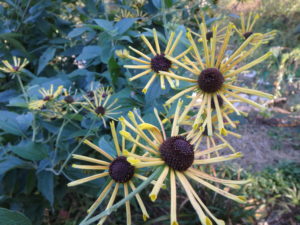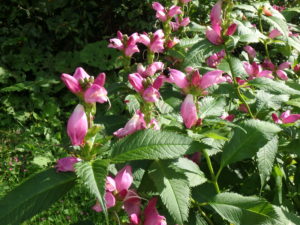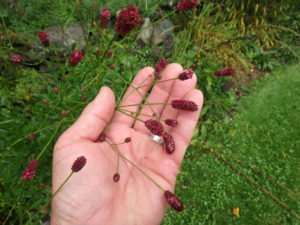Fall Color in the Flower Garden
Big yellow buses are growling as they lumber down country roads, delivering their children to school. Soft serve stands are warning of imminent closure. Favorite flowers are finishing their blooms. Sigh. Fall is here. But don’t despair: there are plenty of colorful plants to fill vases and warm our hearts. Let’s look at a few I like.
Most of us have black-eyed Susans (Rudbeckia spp.) of some sort blooming now, either wild or planted. ‘Goldsturm’ is one of end most common, a nice one that has branched stems loaded with blossoms. But do you know one called ‘Henry Eiler’? It is much taller, and has narrow petals spaced out around the blossom, giving it an airy look. For me it blooms well into October. I have a big clump several years old, and need to tie it to keep the 5- or 6-foot stems from flopping. ‘Prairie Sun’ is wonderful one with a green eye that blooms consistently from July to after Halloween.
Turtlehead (Chelone lyonii) is one of my favorite fall bloomers. Each stem has numerous pink helmet-shaped blossoms an inch long that resemble, well, a turtle head. I love it in part, because it attracts bumblebees that force their way into the blossoms and disappear. I can hear them buzzing inside the blooms.
It does best in rich soil that is consistently moist to wet, but will grow in less desirable soil. I recently saw it on the Maine coast growing in hot, dry sandy soil, though it was much shorter than the 4-to5-foot stems I have. I grow it in full sun and also light shade, and each year the clumps get bigger. I never have trouble with it flopping, but have read that can be a problem in shady locations.
Joe Pye Weed (Eutrochium purpureum) is a native wildflower that appears alongside streams and in wet places. It can be grown in average garden soil, but if it is a dry location, some shade will help it. The small flowers are a pinky purple arranged in panicles that are about 6-inches across. The stems, a dark purple to almost black, contrast nicely with the deep green leaves.
Joe Pye weed is a big plant that requires lots of space. I have one clump that is now more than 8 feet tall, though 6 feet in average garden soil is more the norm. ‘Gateway’ is the best of the named cultivars, I think, but I have heard that a smaller variety called ‘Baby Joe’ is only 3 to 4 feet tall and 2 to 3 feet wide. I’m looking for one to try, as Gateway is too big for most beds. Moving a mature clump is almost impossible without a back hoe – or dynamite. I did it once, and won’t again.
When find a flower I like, I collect other species of the same genus. So it is with the burnets. First I planted Canadian burnet (Sanguisorba canadensis), our native species that grows by streams and wet places. It has white bottle-brush flowers on stems 4- to 6-feet tall in a wet area near my stream. It will bloom well into November.
Other burnets that I grow vary from a 6-inch tight cluster of variegated leaves and tiny burgundy blossoms to 6-foot tall plants with deep burgundy bottle-brush blossoms. Sanguisorba obtusa and S. stipulata are two of the species I grow, though the plant tags are long gone, so I’m not sure which is which. The foliage for most of the summer is very nice. I grow burnets in sun and rich garden soil.
Blooming now, obedient plant (Physostegia virginiana) is one of the least obedient plants I have grown. I have banished it to the edge of the woods in areas that would otherwise be just weeds. The pink or white flower spikes are great cut flowers, but the plant just won’t sit still. Its roots move fast, colonizing and pushing out well behaved plants. And it is tall: 3 to 8 feet!
The variegated form, however, is not a thug. It grows just to 3-feet tall; it does tend to flop, but it blooms later and doesn’t attempt to take over the world. It too, has pink flowers. Worth trying. Mine is yet to bloom this season.
Although I am a little far north to make my Arkansas amsonia (Amsonia hubrechtii) as big and bodacious as it is in places like Pennsylvania, it is still a great plant. Its steely blue flowers in June and July are nice, and the finely cut foliage is good all summer. But in the fall it excels: its leaves turn a lovely yellow that would make the plant worth growing, even without any flowers. Mine now stands nearly 3 feet tall and wide, and it gets even bigger in warmer locations.
Lastly I have to tip my hat to all those wonderful hydrangeas. Hybridizers have developed so many different named cultivars that I can’t keep track of them all. I’m not talking about the blue one, mysteriously called ‘Endless Summer’ which should be ‘Endless Disappointment’. It often fails to perform well after year one.
The classic PeeGee hydrangea has big white clumps of flowers that, if cut now, will look good in a dry vase all winter. And I love the pink ones like ‘Pinky Winky’ and ‘Pink Diamond’ (my personal favorite). ‘Limelight’ is a white blossom with green overtones, another great one.
So go to your local, family-run garden center and ask what they have that blooms now, and until late fall. Your garden doesn’t have to be dull now.
Next June I hope to help lead a Viking River trip down the Seine from Paris to Normandy. Interested? Just e-mail me at henry.homeyer@comcast.net. I’ll be giving garden talks in the evenings, and we’ll see Monet’s garden along the way.






